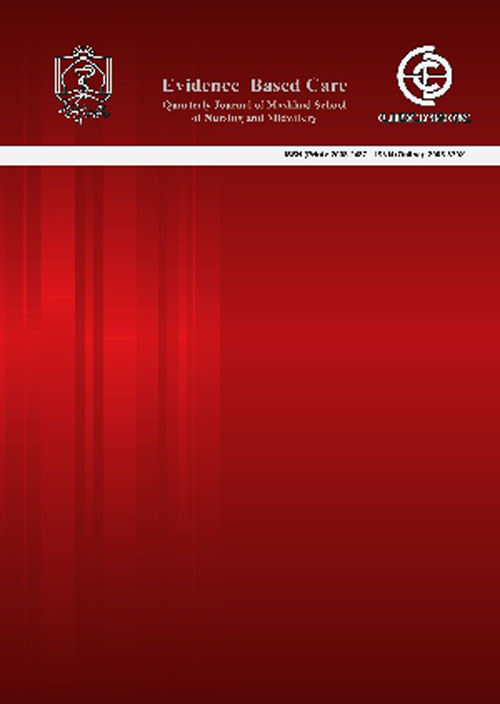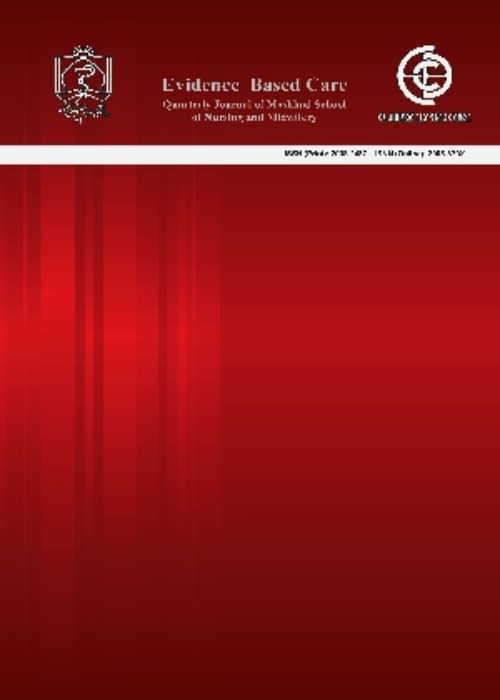فهرست مطالب

Evidence Based Care
Volume:10 Issue: 4, Winter 2021
- تاریخ انتشار: 1400/04/15
- تعداد عناوین: 8
-
-
Pages 7-16BackgroundThe birth and protection of premature infants cause major stress in their mothers. The implementation of strategies to reduce this stress is one of the major tasks of nursing researchers.AimThis study aimed to investigate the effects of telenursing on the level of stress in mothers with premature infants, following the infants’ discharge from the Neonatal Intensive Care Unit.MethodThis clinical trial was conducted on 120 mothers who were randomly assigned into intervention and control groups. Data collection was performed using Barry and Jones’s parental stress scale and the maternal and neonatal demographic questionnaire. Telenursing was performed to educate mothers in the intervention group using the Telegram application for four weeks. The control group only received the usual care at discharge. Data were collected one day after discharge, one day, and four weeks after intervention and analyzed in SPSS software (version 19) through the Kolmogorov-Smirnov test, independent t-test, and Kruskal-Wallis test.ResultsThe mean maternal stress level±SD was estimated at 70.8±8.8 and 70.6±8.9 in the intervention and control groups, respectively. These numbers changed to 53.0±1.8 and 59.8±2.8 in the intervention group and 68.1±2.4 and 59.8±5.1 in the control group immediately and four weeks after intervention (telenursing), respectively. Therefore, the mothers in the intervention group experienced less stress (P<0.001).
Implications for Practice: The application of this low-cost and affordable method is recommended for its impact on the reduction of mean maternal stress levels in the intervention group compared to the controls.Keywords: Neonatal Intensive Care Unit, Premature Infants, stress, Telenursing -
Pages 17-24Background
Nurses are at the forefront of dealing with patients and providing them with many services during Covid-19 pandemic and the most work stress is directed to this high-risk group.
AimThe current study aims to investigate nurses who have experienced COVID-19 patient care.
MethodEighteen participants were purposefully selected and participated into this qualitative study by using a conventional content analysis method. Data were obtained through semi-structured interviews. Participants included Nurses working in the Covid-19 wards of educational hospitals of Shahid Beheshti University of Medical Sciences where considered as hospitalization center for these patients. Purposive sampling continued from 25 June to 9 September of 2020 until the data were completed. The data were analyzed based on Graneheim and Landman’s approach by MAXQDA 10 software.
ResultsThe results of the data had two categories, Organizational Structure Challenges with five subcategories (high workload, deficiency in management, lack of facilities and equipment, irregularity and financial motivation) and care difficulty with four subcategories (psychological concern, recovery and treatment, insufficient care training programs and personal self-protection). Implications for Practice: Considering the position of nursing and expressing their views on the care of patients with Covid-19 can be an important step to improve the management care in these conditions.
Keywords: Nursing care, Pandemic, Qualitative study -
Pages 25-31Background
Chemotherapy is associated with various physical and psychological complications such as fatigue and anxiety in children. Although hospital clowning completely affects health care in pediatric patients, it is a little-known distraction approach in children undergoing chemotherapy in Iran.
AimThis study aimed to investigate the effect of hospital clowning on anxiety and fatigue in children with cancer undergoing chemotherapy.
MethodThe participants in this clinical trial were 7-15-year-old children (n = 18) with cancer undergoing chemotherapy in a hospital in southeastern Iran, 2019. Participants were selected using convenience sampling and randomly assigned to the intervention (n=40) and control groups (n=40). The intervention group and clown participated in different games for two weeks, 3 sessions per week, and each session lasted 2 to 3 hours in the playroom of the oncology ward. The control group received routine care. A demographic survey, the Revised Children's Manifest Anxiety Scale (RCMAS), and the Visual Analog Fatigue Scale (VAFS) were completed before and immediately after the intervention by interviewing the two groups. Data were analyzed by IBM SPSS v.21 using the Independent t-test, Paired t-test, and Chi-square.
ResultsThe mean and standard deviation of the age in the intervention and control groups were 9.61±2.84 and 9.65±2.28 years old, respectively. The mean difference between anxiety and fatigue in the two groups was significantly different after hospital clowning (p <0.001). Implications for Practice: The present study indicated that hospital clowning reduced anxiety and fatigue in children with cancer undergoing chemotherapy. Using hospital clowning is recommended in clinical wards due to the negative effects of anxiety and fatigue on the treatment of children with cancer.
Keywords: Anxiety, Cancer, chemotherapy, Fatigue, Hospital clowning -
Pages 32-39Background
Treatment adherence in diabetics is an important challenge in controlling diabetes. Health literacy is a great determinant of health. Future studies need to address determinants of adherence, as this may be crucial.
AimDetermining the association between health literacy and treatment adherence to the treatment regimen in women with gestational diabetes.
MethodThe present cross-sectional study was conducted on 260 women with gestational diabetes receive nutrition therapy from September to January 2019. The subjects were selected by multistage sampling methods from ten health centers and Imam Reza, Ghaem, and Ommolbanin Hospitals of Mashhad. Data were collected by the brief Test of Functional Health Literacy in Adults (TOFHLA), and a researcher-made questionnaire of adherence to the treatment regimen (diet, exercise, and blood sugar monitoring) with verified validity and reliability. Data were analyzed using SPSS 16.
ResultsSpearman's rank correlation coefficient indicated significant direct relationships between health literacy and the score of dietary adherence (p <0.001, r=0.314), blood sugar monitoring (p <0.001, r=0.241), exercise adherence (P=0.009, r=0.162) with total adherence to the treatment regimen (p <0.001, r=0.356). Implications for Practice: Promoting health literacy through educational interventions in mothers with gestational diabetes is essential according to its relation to raise dietary adherence (diet, exercise, blood sugar monitoring).
Keywords: Diet therapy, Gestational Diabetes Mellitus, Health Literacy, treatment adherence -
Pages 40-48BackgroundProblems associated with the conditions of children undergoing hemodialysis (HD) have significant effects on maternal physical and mental health status. Therefore, the provision of information and support to mothers of children receiving HD can have a profound impact on the health status of mothers.AimThe present study aimed to investigate the effect of participation in peer-support groups (PSGs) on happiness and life orientation in mothers of children undergoing HD.MethodThis longitudinal single-group study with interventional study design, with a pre/post-test research design, was conducted on 27 mothers who were referred to Dr. Sheikh Hospital, Mashhad, Iran, during 2019-2020. The mothers were divided into six groups and attended PSG sessions. The data were collected using demographic characteristics/ medical history questionnaire, the Oxford Happiness Inventory (OHI), and the Revised Life Orientation Test (LOT-R) three times before and three times after the intervention. The data analysis was performed using the SPSS software (version 25).ResultsIn this study, the mean±SD age of participants in the PSG was 38.00±5.50 years. A significant difference was observed in the mean±SD scores of happiness at the pre-and post-intervention stages (P˂0.001). Moreover, there was a significant difference in the mean±SD scores of life orientation before and after intervention (P˂0.001). Implications for Practice: Participation in PSGs can boost levels of happiness and positive life orientation in mothers of children receiving HD. Therefore, nurses are suggested to practice this intervention as an effective strategy.Keywords: Happiness, hemodialysis, Life Orientation, Mother, Peer-support group
-
Pages 49-58BackgroundFoot massage is a distraction technique that can be used for directing children's attention away from the painful stimuli during invasive procedures.AimThis study aimed to assess the effect of foot massage on pain intensity among hospitalized preschoolers undergoing venipuncture.MethodSeventy preschoolers were selected using convenience sampling in the present clinical trial, at theinternal pediatric ward of Besat Hospital, Hamadan, Iran. They were randomly allocated into the experimental (n=35) and control groups (n=35). The experimental group was received a foot massage 5 minutes before venipuncture. The pain intensity was measured using the Face, Legs, Activity, Cry, Consolability scale immediately and two minutes after catheter insertion. Heart rate and arterial oxygen saturation were measured using a pulse oximeter five minutes before, immediately, and two minutes after catheter insertion as pain physiological indicators.ResultsThe mean±SD of pain intensity in the experimental group and in the control group immediately and two minutes after intravenous catheter insertion were 2.71±1.36 and 1.11±0.86, and 7.54±1.33 and 4.20±1.52, respectively. The mean of pain intensity immediately and two minutes after venipuncture revealed a significant difference between the experimental and control groups (p <0.001). The mean of heart rate and arterial oxygen saturation between the two groups were significantly different only immediately after venipuncture (p <0.001). Implications for Practice: This finding is clinically important in nursing care for reducing pain and anxiety as well as decreasing drug-related complications and adverse effects. Instructing and using this method are suggested to medical personnel, especially nurses.Keywords: Massage, Pain, Preschoolers, Venipuncture
-
Pages 59-66Background
Major thalassemia has a significant impact on the personal performance and life of the affected person and leads to reduced quality of life (QoL) of the patient. One of the ways to improve quality of life is to use the Continuous Care Model (CCM).
AimThis study aimed to determine the impact of CCM on the QoL of patients with thalassemia major.
MethodA clinical trial was performed with 60 thalassemia patients referring to Aliasghar Hospital in Zahedan, Iran. Eligible candidates were selected by convenience sampling method and randomly assigned to the intervention and control groups (n=30 each). Data collection tools included a demographic form, the quality of life questionnaire the brief version of the World Health Organization's QoL, and a self-control checklist. The intervention was performed in six training sessions three times a week in the presence of the patient and a family member; however, the control group received no intervention. Data analysis was performed in SPSS software (version 21).
ResultsThe mean scores of QoL and its dimensions showed no significant difference between the intervention and control groups before the intervention (P>0.05); nevertheless, a significant difference was observed one and three months after the implementation of the model regarding (P<0.05). Implications for Practice: The finding indicated that the CCM improved the QoL of patients with major thalassemia. The model can be suggested as an intervention in nursing care to increase patients’ QoL.
Keywords: Continuous care model, Quality of life, Thalassemia major -
Pages 67-74Background
Circumcision is a common surgery and causes severe pain and anxiety in children. Today, virtual reality is used as an easy and cost-effective non-pharmacological method to manage pain and anxiety with no side effects.
AimThis study aimed to investigate the effect of virtual reality on the reduction of pain and anxiety in children who underwent circumcision.
MethodThis single-blind randomized clinical trial was performed on 40 children in 2019. The research instruments included the demographic survey, the Observational Scale of Behavioral Distress, and the Oucher pain scale which were completed in both groups 30 min before and after the circumcision (immediately after dressing the surgical wound). Anxiety immediately before circumcision. The children’s pain was assessed during anesthesia in both groups. A two-step intervention was performed on the experimental group. A preoperative virtual reality training video and a virtual reality animation were presented to distract the patients during the circumcision. All these steps except virtual reality were performed in the control group. Data were analyzed using SPSS software (version 16).
ResultsVirtual reality as a distraction technique significantly reduced anxiety and pain at the onset of circumcision (p <0.001) and during anesthesia (p <0.001) as well as pain (P=0.005) and anxiety (p <0.001) at the end of the circumcision in the intervention group compared to the control group.
Implications for Practice:
Clinical use of virtual reality can be used for the reduction of pain and anxiety in children during the circumcision process.
Keywords: Anxiety, Child, Circumcision, Male, Pain, Virtual reality


